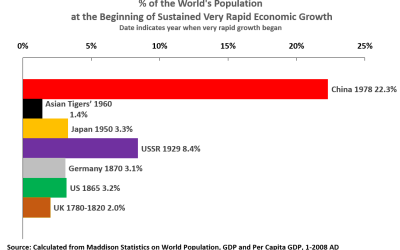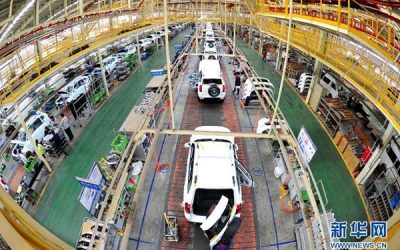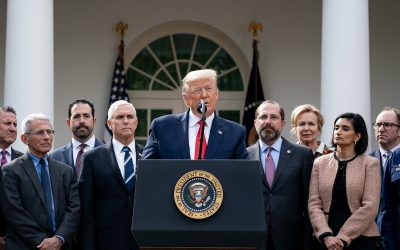Bremmer, Ian: 12 November 2011
‘The world’s three largest economies can’t continue along their current paths, and everybody knows it. Investors watch nervously for signs that China is headed toward a hard landing, that America will sink back into recession, and that the euro zone will simply implode.
‘In all three cases, kicking the can down the road has staved off disaster so far, but the cans are getting bigger and heavier. Which economy will be the first to stumble on its problems?…
‘In China… It has been… three years since the financial crisis made clear that China’s growth remains dangerously dependent on exports to Europe, America and Japan.
‘To ensure long-term economic expansion (and political stability), Beijing must figure out a way to encourage Chinese consumers to buy more of the products that local manufacturers make. This will demand a massive transfer of wealth from the state and China’s state-owned companies to Chinese households.
‘But Beijing is moving in the opposite direction. The leadership responded to Western market turmoil not by boosting consumption but by increasing state and private spending on fixed investment, which now accounts for nearly half of China’s growth. The result has been an explosion in residential and commercial real estate, more state spending on infrastructure and more cheap loans from state-owned banks to state-owned enterprises.
‘Indeed, a key obstacle to reform is that China remains so heavily invested in its state-managed model of capitalism. Of the 42 Chinese companies listed in the 2010 edition of the Fortune 500, 39 were state-owned enterprises, and three quarters of China’s 100 largest publicly traded companies are government controlled. Party officials with a stake in the success of state-owned enterprises have amassed considerable power within the leadership, and they ferociously resist efforts to transfer away their wealth to private enterprises and ordinary citizens.
‘China has the cash and foreign reserves to postpone a crisis. But growth is slowing, financial stresses are rising, and there is good reason to fear that China’s days of can-kicking are numbered as well…
‘Make no mistake: The challenges that the U.S. faces are formidable, and persistent political gridlock could delay badly needed fiscal and structural reforms. But everything is relative, and the best can to be kicking down the road just now is undoubtedly the one made in America.’ (Written with Nouriel Roubini)
Chang, Gordon:
June 2002 The Coming Collapse of China pxxiii ‘A half-decade ago the leaders of the People’s Republic of China had real choices. Today they do not. They have no exit. They have run out of time.’
On the BBC 25 December 2015
‘Gordon Chang, author of the 2001 book, The Coming Collapse of China, argues that growth in China was actually 3% at most in 2015.
‘”China’s leaders no longer have the ability to prevent the economy from tumbling down,” he says.
‘Interest rate moves have been ineffective and a dramatic recent increase in government spending hasn’t helped much either, he argues.
'”The leadership is now without tools”‘
Council on Foreign Relations (US): Report ‘Economic and Geopolitical Fallout From China’s Slowing Growth’ 25 February 2016
‘The most common forecast was that China will avoid a hard landing but fall short of implementing necessary reforms, sentencing it to something similar to Japan’s “lost decade” of the 1990s, with average real growth rates around 1 to 3 percent’.
Council on Foreign Relations (US): cited in Wall Street Journal 5 April 2016
’At a recent workshop hosted by the Council on Foreign Relations, a nonpartisan U.S. think tank, participants—35 or so academic economists, Wall Street professionals and geopolitical strategists—lined up around three different growth scenarios for China. Only 31% chose the optimistic one, defined as 4% to 6% annual growth, dependent on leaders successfully implementing reforms; 61% foresaw a “lost decade” of 1% to 3% growth; the rest thought a so-called hard-landing, or contraction, was most likely.Of course it wasn’t a scientific survey, but what’s interesting is that apparently nobody considered the possibility that the Chinese government could deliver on its promise of “medium to fast” growth, meaning 6.5% or higher.
Duncan, Richard: 17 February 2011
‘regardless of what happens in the US, China is facing a much more difficult future than is generally believed. Every boom busts. Every bubble pops. China will be no exception.
‘It is a serious mistake to believe China’s economy will continue to grow at 8 per cent or more for the next decade. That’s what people believed about Japan in 1989. Today, Japan’s economy is no larger than it was in 1993, if you don’t adjust for deflation. 2 per cent to 4 per cent annual GDP growth would be an excellent outcome for China over the decade, in light of the enormous capital misallocation that has occurred there over the past 10 years.’
Economist, The: 15 June 2002 ‘A dragon out of puff’
‘In the coming decade, therefore, China seems set to become more unstable. It will face growing unrest as unemployment mounts.’
”the economy still relies primarily on domestic engines of growth, which are sputtering. Growth over the last five years has relied heavily on massive government spending. As a result, the government’s debt is rising fast. Coupled with the banks’ bad loans and the state’s huge pension liabilities, this is a financial crisis in the making.’
Francis, David: Foreign Policy Magazine 14 July 2017
‘given China’s deep-seated economic woes — rising labor costs; crushing corporate and government debt; woefully inefficient state firms; rampant pollution; a dearth of arable land and clean water; and a shrinking workforce — many experts are a lot more worried about a Chinese slowdown than about Beijing stealing the global economic crown.’
Keen, Steve: 8 October 2015
‘China crash will occur and add to global stagnation caused by excessive private debt.’
Krugman, Paul: 14 March 2010
‘The International Monetary Fund expects China to have a 2010 current surplus of more than $450 billion — 10 times the 2003 figure.’ China’s actual current account surplus in 2010 turned out to be $237 billion. Krugman never explained why he accepted this wholly inaccurate and unsubstantiated figure.
Magnus, George 16 August 2014
‘During Xi’s period in office, which runs to 2022, I expect China’s GDP growth to slide to 4-5%, and there
may be periods when growth doesn’t even make it to this level.’
J.P. Morgan: reported by Business Insider 15 March 2012
JP Morgan’s Adrian Mowat said that the slowdown has been much more severe and would characterize a hard landing. From Bloomberg’s Weiyi Lim:
“If you look at the Chinese data, you should stop debating about a hard landing,” Mowat, who is based in Hong Kong, said at a conference in Singapore yesterday. “China is in a hard landing. Car sales are down, cement production is down, steel production is down, construction stocks are down. It’s not a debate anymore, it’s a fact.”
…
“One should be concerned about what’s happening in the China property market,” Mowat said at yesterday’s conference. “People are too complacent that the government can turn what’s going on in this market.”
…
“What you can look forward to is to see a pickup in property demand that will clear up the inventory; that doesn’t appear likely,” Mowat said in an interview after the conference yesterday. “I don’t see any evidence of a policy move that will cause the economy to reaccelerate.”
Pettis, Michael: 14 August 2009
‘I continue to stand by my comment last year… that the US would be the first major economy out of the crisis and China one of the last.’
‘I still maintain that average growth in this decade will barely break 3%.’ 11 March 2012
Roubini, Nouriel: 12 November 2011
‘The world’s three largest economies can’t continue along their current paths, and everybody knows it. Investors watch nervously for signs that China is headed toward a hard landing, that America will sink back into recession, and that the euro zone will simply implode.
‘In all three cases, kicking the can down the road has staved off disaster so far, but the cans are getting bigger and heavier. Which economy will be the first to stumble on its problems?…
‘In China… It has been… three years since the financial crisis made clear that China’s growth remains dangerously dependent on exports to Europe, America and Japan.
‘To ensure long-term economic expansion (and political stability), Beijing must figure out a way to encourage Chinese consumers to buy more of the products that local manufacturers make. This will demand a massive transfer of wealth from the state and China’s state-owned companies to Chinese households.
‘But Beijing is moving in the opposite direction. The leadership responded to Western market turmoil not by boosting consumption but by increasing state and private spending on fixed investment, which now accounts for nearly half of China’s growth. The result has been an explosion in residential and commercial real estate, more state spending on infrastructure and more cheap loans from state-owned banks to state-owned enterprises.
‘Indeed, a key obstacle to reform is that China remains so heavily invested in its state-managed model of capitalism. Of the 42 Chinese companies listed in the 2010 edition of the Fortune 500, 39 were state-owned enterprises, and three quarters of China’s 100 largest publicly traded companies are government controlled. Party officials with a stake in the success of state-owned enterprises have amassed considerable power within the leadership, and they ferociously resist efforts to transfer away their wealth to private enterprises and ordinary citizens.
‘China has the cash and foreign reserves to postpone a crisis. But growth is slowing, financial stresses are rising, and there is good reason to fear that China’s days of can-kicking are numbered as well…
‘Make no mistake: The challenges that the U.S. faces are formidable, and persistent political gridlock could delay badly needed fiscal and structural reforms. But everything is relative, and the best can to be kicking down the road just now is undoubtedly the one made in America.’ (Written with Ian Bremmer)
Summers, Larry: quoted in the Wall Street Journal 5 April 2017
‘Mr. Summers thinks that after decades of extraordinary growth China will inevitably experience a “reversion to the mean.” In other words, it will become merely average, crawling ahead at around 2% along with its peers.’
Wall Street Journal 5 April 2016
‘At a recent workshop hosted by the Council on Foreign Relations, a nonpartisan U.S. think tank, participants—35 or so academic economists, Wall Street professionals and geopolitical strategists—lined up around three different growth scenarios for China. Only 31% chose the optimistic one, defined as 4% to 6% annual growth, dependent on leaders successfully implementing reforms; 61% foresaw a “lost decade” of 1% to 3% growth; the rest thought a so-called hard-landing, or contraction, was most likely.Of course it wasn’t a scientific survey, but what’s interesting is that apparently nobody considered the possibility that the Chinese government could deliver on its promise of “medium to fast” growth, meaning 6.5% or higher…
‘All this matters because, as former U.S. Treasury Secretary Larry Summers wrote recently, China for the first time in centuries “affects the global economy as much as it is affected by the global economy.” Mr. Summers thinks that after decades of extraordinary growth China will inevitably experience a “reversion to the mean.” In other words, it will become merely average, crawling ahead at around 2% along with its peers….
’In the West, at least, pessimism about China’s outlook has become the mainstream sentiment. Or as Mr. Levi of the Council on Foreign Relations says, 4%-6% growth has become “code for doing well.”The bears have come in from the cold. And the growling of the permabears keeps Ms. Yellen and other central bankers awake at night.’
Elliot Wilson, The Spectator 15 August 2015
‘This week China devalued its currency by 3.6 per cent in a dramatic bid to encourage exports — a clear sign that Beijing is panicking. Forget Greece. This could be the biggest financial story of the year. Even the threat of a significant slowdown in China’s economy could be enough to send the rest of the world tumbling back into recession…
‘The picture isn’t pretty. From the polluted central metropolis of Zhengzhou, to Shenyang in the rustbelt northeast, the overwhelming sense is one of pessimism and urban decay. Idle cranes and vacant building sites dot the landscape. The ghost towns of legend — such as Ordos City in Inner Mongolia — are all too real, and remain a silent, cautionary reminder of the perils of engineered growth…
‘That aspirational industrial lo
gic — if you build it, the customers will come — once served China well. No longer.’Over the past year, every key indicator has begun pointing to bad times ahead. Electricity consumption, usually the most reliable single gauge of economic health in the mainland, expanded at the slowest rate in three decades in the year to June…
’Predicting a serious slowdown in the mainland has long been a losing bet. Ask the Sino-American author Gordon Chang, whose book The Coming Collapse of China was released at the turn of the century, just as the mainland began its inexorable rise. Since then, China has dealt with every challenge thrown its way. Even the global financial crisis barely registered…
'[A] realistic assessment comes from Andrew Polk, a senior economist at The Conference Board (TCB) in Beijing, who believes output grew at 4 per cent in each of the past two years, and will continue to expand at or below that rate for the foreseeable future. ‘For a fast-growing emerging market like China’s, which is in the mode of playing catch-up with the wider world, a growth rate of 3 per cent or 4 per cent is in or close to recession,’ he says. ‘It’s like zero growth in a mature economy like Britain’s or America’s.’
Projections that will be shown to be wrong
EIU 9 August 2017
The Economist Intelligence Unit (EIU) has forecast a dramatic slowdown in China’s economy: ‘Growth will slow to 4.8% a year on average in 2018-19.’






